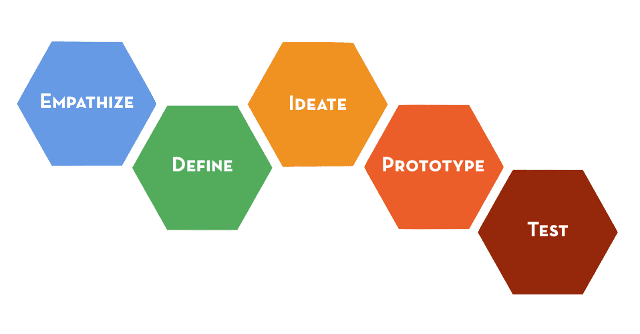Why Human-Centered Design Matters in International Development
Human-centered design is revolutionizing software development in the tech sector. Can the process of design thinking help create better solutions for international development, too? Learn how design principles for technology can reduce poverty in the latest edition of Tech vs. Poverty, a new column by Director of TechnoServe Labs Dave Hale.

Human-centered design (HCD) seeks to answer a critical question: How do we generate creative tech solutions to some of the most difficult international development challenges in a way that is firmly based on an understanding of, and empathy with, the end user?
In my last Tech vs. Poverty article on user profiles and UX design, I spoke to the importance of understanding user context before developing solutions. Today, we’ll discuss how human-centered design provides a methodology for identifying creative solutions to difficult challenges in international development.
What is Human-Centered Design and Why Does it Matter?
At TechnoServe, we create user profiles to represent the average participants in each of our programs. These user profiles roughly approximate important attributes within each user group, such as:
- Literacy levels
- Access to technology
- Internet access
As a tool for rough classification, however, user profiles cannot fully capture the nuanced context for each demographic and the wide range of needs for specific users within these groups.
Gaining more in-depth insight into the vast range of user needs requires a more comprehensive and sophisticated approach in the product development cycle, especially for programs as diverse in purpose and geographic location as TechnoServe’s. That’s where human-centered design comes into play.
Applying Design Thinking to Technology Solutions for Poverty
Design-thinking concepts have been around for a long time. In the 1980s at Stanford, I was fortunate to take David Kelley’s course ME-101: Visual Thinking, which included many exercises that have evolved into design thinking.
As essential as human-centered design has proven to be, companies and academics have only started to recognize it as a core discipline within the past 25 years.
Further, only in the past decade have non-governmental organizations and government agencies started incorporating design thinking and human-centered design as essential best practices that make technology-enabled solutions more effective.
At TechnoServe, we recognize that the user profile alone is insufficient. We also need to understand the user context and then use it as a starting point for defining the problem to be solved.
User empathy and understanding becomes the basis for solution ideation, then rapid iteration with user feedback.
Case Study: Using Human-Centered Design to Help Coffee Farmers in Ethiopia
There are roughly 12.5 million smallholder coffee farming families in the world, and over 80% of them are still living below the poverty line. TechnoServe helps coffee farmers increase their incomes by working with them to enhance the quality and yields of their coffee while promoting value chain improvements that enable farmers to earn a larger share of export prices.
In Ethiopia, we noticed a need to find creative ways to encourage farmers to increase their adoption of good agricultural practices such as mulching, weeding, stumping, and pruning their coffee trees. These practices have been proven to increase incomes by 30-50% over 3-4 years, but many farmers are hesitant to adopt these practices because they are expensive or their yields will decrease temporarily while the trees grow back.
In response, TechnoServe Labs developed a two-week training program for staff intended to help them address this challenge. The program was built on the OpenEdX learning platform and consisted of videos, short reading assignments, and four 1-2 hour workshops.
The first webinar addressed HCD principles, the second covered rapid prototyping – or “pretotyping” – and the final two workshops applied the HCD process to the specific challenge staff was facing in Ethiopia.
TechnoServe Labs trained staff on good interviewing techniques so that they could effectively interview farmer trainers, farmers, and cooperative members. Homework consisted of preparing and completing field interviews over the phone.
Insights from the interviews were both surprising and, in retrospect, logical. The core learning was that to increase good agricultural practice adoption, we need to address trust and communication first.
Instead of focusing our attention on the problem of improving training content, we focused on ways to increase trust. We identified a series of ideas that we are now iteratively testing.

Applying HCD to Design Processes
There are several different processes for HCD – IDEO’s design process, the Stanford d.School design thinking process, MIT D-Lab’s Creative Capacity Building, and others. All of the different schools of thought define HCD (also known as user-centered design or design thinking) as a methodology for generating creative solutions to difficult problems — starting with a foundation of understanding and empathy with users.
Humans are natural problem solvers, so in the absence of a methodology like HCD, we tend to leap to solutions first. The typical process works like this:
→ “I have this cool idea for an app.”
→ “I think it might be a good fit for this tough problem.”
→ “Users will LOVE it!”
This is exactly backward: solution first, then map to the problem, then think about the users with the problem. HCD puts the human — the user — back at the front of the process.
The 5 Steps of Design Thinking
The core of design thinking is starting with a deep understanding of the user’s world. At TechnoServe, we like the Stanford d.School model:

The Stanford approach works for us because it includes an explicit “Define” stage that follows the “Empathize” stage, where teams conduct user interviews and analyze the core themes from their interviews.
The first step is understanding how users live and think. Because over 90% of TechnoServe staff is in the field and has strong relationships with local communities, the HCD methodology is a natural extension of the way TechnoServe has operated over its 50-year history. But the “Empathize” step still often yields surprising insights.
Once the team has a clear vision of the user’s mindset and world, designers and developers define the problem to be solved, based on the authentic users’ real-world challenges, rather than mere theory.
Then we generate many possible solution ideas and do rapid iterative testing based on user feedback. Often the tests involve partial solutions to get user feedback on a specific aspect of a solution with a small subset of users.
By getting user feedback as early in the process as possible, we are able to develop better solutions more quickly than if we wait to build more complete or perfect solutions. Software developers will recognize this as a component of the Agile Manifesto. Maybe we can call it “Agile Impact.” Whatever you call it, the process is working for TechnoServe.
Human-centered design has become an important tool to help TechnoServe build better solutions. We are committed to using technology in a way that is grounded in local knowledge and an understanding of the needs of the end user.




